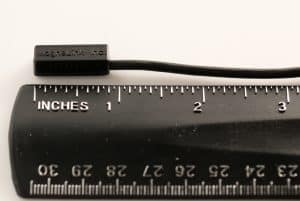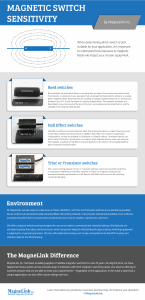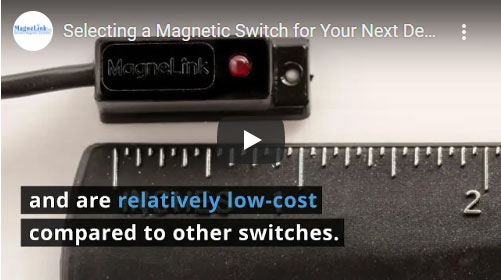Selecting a Magnetic Switch for Your Next Design
 Magnetic switches, as their name suggests, are devices that allow or disallow the flow of current based on the presence of a magnetic field. There are several types of magnetic switches, each possessing specific characteristics that lend themselves to different applications. When designing or selecting a magnetic switch, it is essential that parameters such as application type, circuitry and power requirements, magnetic sensitivity, and operating environment are carefully taken into consideration.
Magnetic switches, as their name suggests, are devices that allow or disallow the flow of current based on the presence of a magnetic field. There are several types of magnetic switches, each possessing specific characteristics that lend themselves to different applications. When designing or selecting a magnetic switch, it is essential that parameters such as application type, circuitry and power requirements, magnetic sensitivity, and operating environment are carefully taken into consideration.
The most common types of magnetic switches in use today are Reed switches, Hall effect switches, and Triac or Transistor switches.
Reed switches consist of a pair of overlapping, but slightly separated metal contacts hermetically sealed in a small glass tube. When a magnetic field is present, the contacts are drawn together, completing the circuit.
Hall Effect switches are so named because they use the Hall Effect Principle to detect the presence of a magnetic field. When current flowing through the conductor is exposed to a magnetic field in a perpendicular direction, a potential difference (voltage) is generated in a transverse direction across it, thus triggering the switch.
Triac and Transistor switches are similar semiconductor devices with the ability to regulate the flow of current in a circuit. A Triac or Transistor switch, when used with a Reed or Hall Effect device, is triggered by small currents and voltages and is used to control significantly larger currents and voltages in an electrical circuit. Of all three switches, Triac or Transistor switches are the best suited for switching larger, or inductive-type, loads.
Magnetic Switch Applications
The construction and operating principles of the different switches make each suitable for different applications—although there are instances where there may be some overlap.
Reed switches are highly sensitive to magnetic fields, customizable, and are relatively low-cost compared to other switches. These switches are commonly used in proximity or limit switch applications, such as security alarms, doors in household appliances, cell phones, and doors on vehicles or heavy machinery.
Hall Effect switches are semiconductor devices. As such, they have no mechanical contacts. This gives Hall Effect switches an advantage of being less prone to damage due to mechanical shock. Hall Effect switches are commonly used as limit switches in actuators which can be found in factory automation equipment, elevator cars or vehicles.
Triac or Transistor switches are the most complex of these switch types, as they add more circuitry to the switch. Triac switches are designed for switching and power control applications in AC voltage systems, whereas Transistor switches are designed for switching and power control applications in DC voltage systems. Both switches are robust, making them ideal for more heavy duty, higher-current switching applications. They are commonly used for controlling relays, motors, or other inductive type loads.
Circuitry, Electrical Current, and Power Load Requirements
The Reed switch is the only one of the three switches that is considered a “dry contact” switch, and as such, is not required to be powered at all times. Due to the simplicity of Reed switches, they can be tested out of their circuit with a simple ohmmeter. Reed switches carry the switched current of the circuit when they make contact. Therefore, it is important to choose a reed with the proper Contact Rating for the power draw in the circuit. Choosing too small of a reed for a design could lead to a shorter switch life.
Hall Effect switches are ideal for low-to-medium DC power applications. They do require constant power to be supplied in order to function properly. Therefore, these switches need to be tested under load.
Triac and Transistor switches are best suited for higher power loads in AC voltage or DC voltage environments, respectively. Like the Hall Effect switches, they also need to be tested under load.
Magnetic Fields & Sensitivity

Reed switches
Reed switches are mechanical devices, meaning they are subject to excessive mechanical shock from impacts or vibrations in your operation that can disrupt magnetic fields. Reed switches are available in varying magnetomotive forces, measured in Ampere-Turns (AT), to suit the needs of a variety of applications. The magnetic sensitivity of a Reed Switch may vary based on the size of the reed, surrounding environmental factors, and the strength of the magnetic field applied.
Hall Effect switches
Hall Effect switches are semiconductors rather than mechanical devices, making them less prone to the risks posed by mechanical shock. In addition, they offer more options for application configurations, as they are available as Omnipolar or Unipolar options. Omnipolar devices can detect either the North or South poles of a magnet, while Unipolar devices sense only one pole. The magnetic sensitivity of Hall Effect switches depends on the electric current applied and the type of magnetic field generated.
Triac or Transistor switches
The current-carrying capacity of Triac or Transistor switches may be increased by using them in conjunction with Reed or Hall Effect switches. Of note, the magnetic sensitivity and mechanical benefits and limitations of the Reed or Hall Effect device used in the switching circuit will still apply.
Environment
At MagneLink, we take steps to make sure our Reed, Hall Effect, and Triac and Transistor switches are as durable as possible. All our switches are protected inside a housing filled with potting material, improving the mechanical durability of our switches and protecting them from environmental contaminants such as dust, weather, washdowns, and more.
We offer a range of switch housings designed for use across various commercial and industrial settings. We fabricate our standard housings from glass-reinforced resin, which has proven adept at withstanding the typical abuse switching equipment is subjected to in general operations. We also offer alternate housings such as die cast aluminum for the MLT housing, and stainless steel for our MLQ housing.
Switches for All Operations
MagneLink, Inc. has been a leading supplier of reliable magnetic switches for over 25 years. During this time, we have helped numerous clients across a broad range of industries with their magnetic switching needs. Our diverse offering of switches ensures that we are able to meet your requirements—regardless of the application. In the event a client has a unique application, we also offer custom design services.
If you would like to learn more about our products or services and how they can improve your operation, feel free to email us or call our sales team at 1-800-638-0801.

